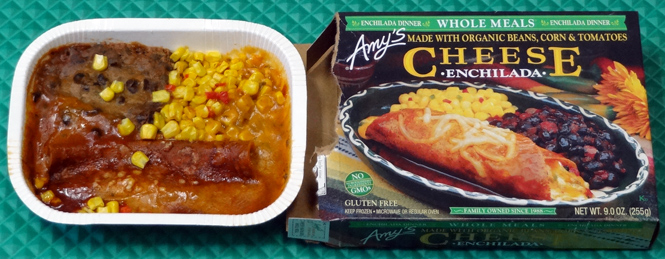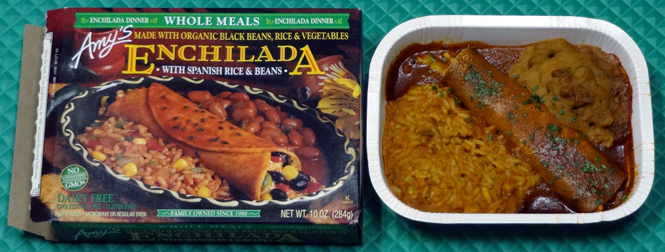Misleading food package photos
Food package photographs often depict the contents as being much more attractive than they actually are. This especially applies to frozen food, as in this example of an Amy's® enchilada “whole meal” (calling it a snack would be more accurate, considering its small size):

Here's another Amy's® product:

When I make something, freeze it, then microwave it, it appears very similar to how it originally appeared. Thus I wonder if food manufacturers use tricks to enhance their appeal.
Care to comment, Amy?
Amy's® food is considerably healthier than most other processed food. They clearly care about nutrition, but even they could do more so their customers enjoy better health and the myriad benefits conferred by it, such as enhanced appearance, longevity, mood, and cognition, including intelligence and creativity.
I could write a book on this subject, but in these days of Twitter-length attention spans, few people would read it. Hence, I'll briefly discuss two facets of nutrition augmenting creativity: increased inventiveness and the ultimate antidote to writer's block.
When I began writing decades ago, I'd often stare at my computer screen, paralyzed by difficulty thinking of what I wanted to write and how I could express it. Often an hour or more would go by with nothing except a flashing cursor, but no words.
Now I can't find the time to write about even 1% of what I'd like to cover; my various books and websites, along with a mountain of unpublished works on my hard drive, are just the tip of the iceberg in what I am just itching to say, which now flows as readily from me as water cascading over Niagara Falls.
But who cares about writer's block? No one other than a smattering of authors. Most folks are buried under a sea of print and aren't clamoring for more. Thus curing writer's block has negligible societal value.
That's not true of increased inventiveness. Invention is the primary catalyst to our economy. We can blame our politicians for our problems, but ultimately they stem from us. If Americans were as inventive as we once were, there would be so much to go around that almost no one would care how the pie was divided.
Sure, Americans produce many inventions, but as I've discussed elsewhere, most of them don't amount to a hill of beans. We need big ideas that fundamentally improve lives. I have some, as you'll see years from now, and as Atari founder Nolan Bushnell said, there are other Steve Jobses. But we need more, because the world is mired in problems that linger too long.
Believe it or not, but food companies such as Amy's® could play a part in solving this problem through better nutrition. Not Nutrition 101 or even 899, but the really advanced stuff. I attended a medical school that emphasized nutrition more than most others, and I've studied it since the 1970s, yet it wasn't until recently that I serendipitously discovered ways to boost creativity from high into the stratosphere along with mood and empathy—something I'd had too little of, too long.
Most food is just tasty, but the best food is the missing link that can make this world a better place by unleashing the potential we all have.
Notes:
- Restaurant learns online reviews can make or break
- Can one have too much empathy? My girlfriend, a psychologist, seems to think I have too much of it, such as when I wanted to give money to a homeless elderly woman or some kids selling Kool-Aid®, as I discussed in an article on working part-time as an ER doctor and doing the right thing.
- My hunger returns soon after eating Amy's® food. I solved that mystery by reading its nutrition labels and seeing how few calories are in their products. If I ate one such “meal” three times per day, I'd look more like a concentration camp survivor and less like a well-fed adult male. This reinforces my opinion that their portion sizes are ridiculously too small. Most people would benefit by consuming less calories, but what's the point of low-cal food if it doesn't suppress appetite for long?
- I can tolerate visual disappointment, but not nutritional letdowns such as seeing how little protein is in some of their “meals”—hence the hunger that boomerangs soon after eating them. Appearing on an episode of CNBC's How I Made My Millions (currently posted on the homepage of their site), owners Andy and Rachel Berliner explained how, although I'd figured that out years before. Rich people love to talk about giving back to the community, but many overlook their customers. On behalf of them, I'll ask for larger portions sizes and more protein, please. Example: Their “Tamale Verde Black Bean” contains only 7 grams of protein in a 291-gram serving, making it about 2.4% protein. If I ate that three times per day, I'd either die or wish I were dead. No responsible nutritionist or dietician would recommend people eat meals that lacking in protein. They call it an entree, which means “the main dish of a meal” in the United States, where it was sold. An entree with 7 grams of protein is a cruel joke.
- Quoting from 3 High-Protein Breakfasts to Boost Weight Loss: “The study … found that a higher protein breakfast results in "improved daily satiety and evening appetite control."”
Comment: So how about more protein, Amy? EVOL foods are just as tasty and the ones I tried include more protein (e.g., their chicken enchilada bake has 21 grams of protein) and, not surprisingly, satisfies my appetite for much longer than Amy's® meals that I call snacks. - Comparing food products with their package photos
- Organic Labels Bias Consumers Perceptions Through the 'Health Halo Effect'
- Health Halo Effect: Don't Judge a Food by Its Organic Label
“The test of a first-rate intelligence is the ability to hold two opposed ideas in mind at the same time and still retain the ability to function.”
— F. Scott Fitzgerald
Reference: Imagining dialogue can boost critical thinking: Excerpt: “Examining an issue as a debate or dialogue between two sides helps people apply deeper, more sophisticated reasoning …”
